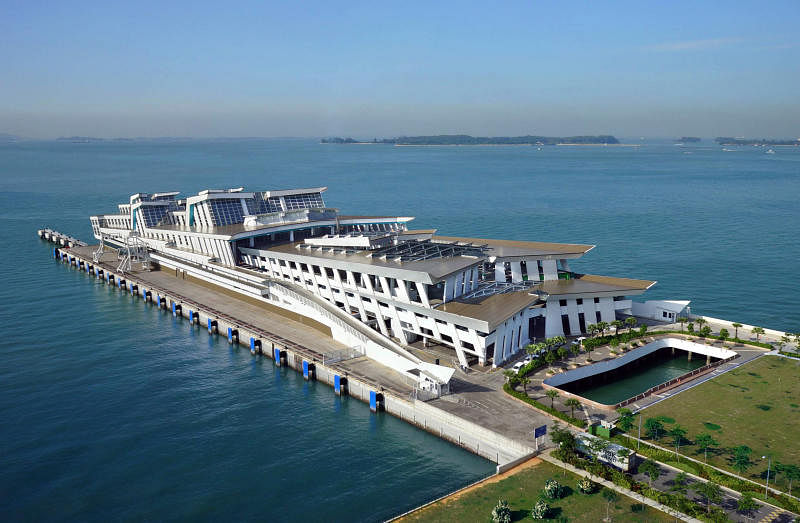SINGAPORE - During the Japanese Occupation in Singapore, pioneer painter Liu Kang set up a small business called Morrow Studio, offering commercial sign painting. The shop disguised his educated background, protecting him from being targeted as a resistance fighter by the Japanese.
Some 70 years later, his son, architect Liu Thai Ker, would borrow the name "Morrow" for his new company, an architecture firm, which officially launches on Friday (Dec 1).
The forward-looking qualities of the name, because it is derived from "tomorrow", and its association with being a safe space as it was for his father, are the good vibes that Mr Liu might need going forward.
It is his first private venture. He spent nearly 50 years as a public servant and senior executive in larger companies. And now, at the age of 79, he has decided to strike out on his own.
The firm has about 40 employees, who made up his team at RSP Architects Planners & Engineers, where Mr Liu spent 25 years as senior director.
RSP, which was bought over by Rowsley, the investment company controlled by billionaire Peter Lim, will move to its new premises in Kallang. Morrow remains in Thong Teck Building in Scotts Road, RSP's old home.
Mr Liu, who previously headed the Housing Board (HDB) and Urban Redevelopment Authority (URA), said he informed RSP of his decision three months ago, when the company began going through corporate restructuring.
He wanted to create "an environment that operates like a smaller studio as opposed to a large corporation".
"Starting something on my own allowed for that," he says, adding that the split was amicable. "It'll also give me a chance to share my experiences and skills with my team and groom them ahead of my eventual retirement."
ARCHITECT OF MODERN SINGAPORE
It is early days yet for Morrow, but its founder sure has a strong sense of "yesterday".
Mr Liu is often referred to as the "architect of modern Singapore" and "Mr HDB", and spent more than two decades in government service, overseeing the modernisation of Singapore.
As the head of the design and research section at HDB in the late 1960s, he came up with a prototype for new towns - the self-sufficient neighbourhood estates that Singapore is known for today.
He also had a hand in the planning, design, development and management of public housing in Singapore. While heading URA in the 1990s, he contributed in the revisions made to the Concept Plan - a plan that arose from the British master plan for Singapore - and had a key hand in firming up policies surrounding conservation projects in Singapore.
Describing his work ethos, he says: "An architect and planner should have the heart of a humanist, the brain of a scientist and the eye of an artist.
"Cities and spaces need to be liveable, they should operate with the efficiency of a machine but overall, as a planner, you cannot forget to treat them like a work of art."
Born in Muar in 1938, the oldest of five siblings grew up in humble circumstances, living on the urban edge of the Malaysian town in a home that reared its own pigs, chickens and ducks.
He recalls of his childhood: "To get a sense of our circumstances, my parents had to save six months to buy me a small bookshelf for my books. They had to save another six months to buy me a bicycle. Those were the struggles of those days - we had to make do with very little."
He had originally wanted to be an artist, like his father, but due to his mother's vocal objections, studied architecture instead.
In 1962, he graduated with a Bachelor of Architecture with First Class Honours from the University of New South Wales.
He went on to study at Yale University where he graduated with a master's in City Planning- topping his cohort for both of his graduate degrees.
Deciding to finally shelve his dreams of being an artist, he came home and joined HDB as the head of design and research in 1969.
"For the first time, I was able to see how I could contribute and make a difference in Singapore," he says. "Having grown up in such difficult circumstances myself, it gave me a sense of purpose in my work. I became the sort of person who would not draw a line without first thinking of the consequences."
One of his early jobs was to come up with the prototype of a new town - for which there was no precedent in the West. So he sought the counsel of everyone from shopkeepers to Ministers of Parliament and academics, eventually coming up with definitions of what constituted towns, neighbourhoods and even precincts.
Over the years, he rose through the ranks, became chief architect at HDB six years later, and eventually chief executive in 1979.
In 1989, having seen Singapore through the elimination of squatters and ghetto areas, Mr Liu made the transition to URA - becoming the organisations' first chief planner and chief executive.
Three years later, he left public service to join RSP as a director finally to pursue his "youthful ambition of being an architect".
With the company, he built up a strong portfolio. In Singapore, he was behind projects such as Marina Bay Cruise Centre Singapore, the Yong Siew Toh Conservatory at the National University of Singapore and the Nanyang Academy of Fine Arts campuses.

One of his biggest projects in China, the Weifang Cultural Centre, which was completed in 2013, spans 294,000 sq m and has been inspired by kites, given its location in the international capital of kites.

The huge development, which has colourful traditional Chinese kite elements peppered all through the architecture, includes a state-of-the-art 1,500-seat grand theatre and a 900-seat concert hall.
PASSION FOR ART
Alongside his career in urban planning and architecture, Mr Liu has been a tireless patron of the arts.
He served as chairman of the National Arts Council from 1996 to 2005, during which he oversaw the entry of Singapore into the Venice Biennale among other things.
He also championed the set-up of the Singapore Tyler Print Institute (STPI) in 2002 and served as its chairman till 2009. STPI is a workshop and art gallery space that promotes experimentation in the mediums of print and paper.
"It is hard to expect Singapore to become a leader in mediums like oil painting or Chinese painting. But I do believe that there is opportunity for experimentation in print," he says of the venture. "My hope with STPI is for Singapore to one day be considered the print capital of the world."
He is also an enthusiastic painter. For the past 35 years, he has been sketching architectural landmarks from all over the world during his travels. His Christmas cards, which feature his artworks, have become iconic among clients and friends.
He is married to Gretchen Liu, a writer, and has two children with her. He has three children from a prior marriage.
The grandfather of five still works 10 hours a day, six days a week ,and has no intention of stopping unless he feels a dip in his energy levels.
For now, he says he does not know "how to even spell the world 'retire'."
With his new firm, he wants to impart his design ethos to the next generation of architects and city planners.
"Architecture needs to be meaningful and modern - it should reflect the locality and the culture of the people," he says. "Today's historical buildings were contemporary in their time. What I am trying to do is design what will hopefully become the historical buildings of the future."


